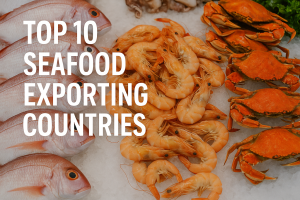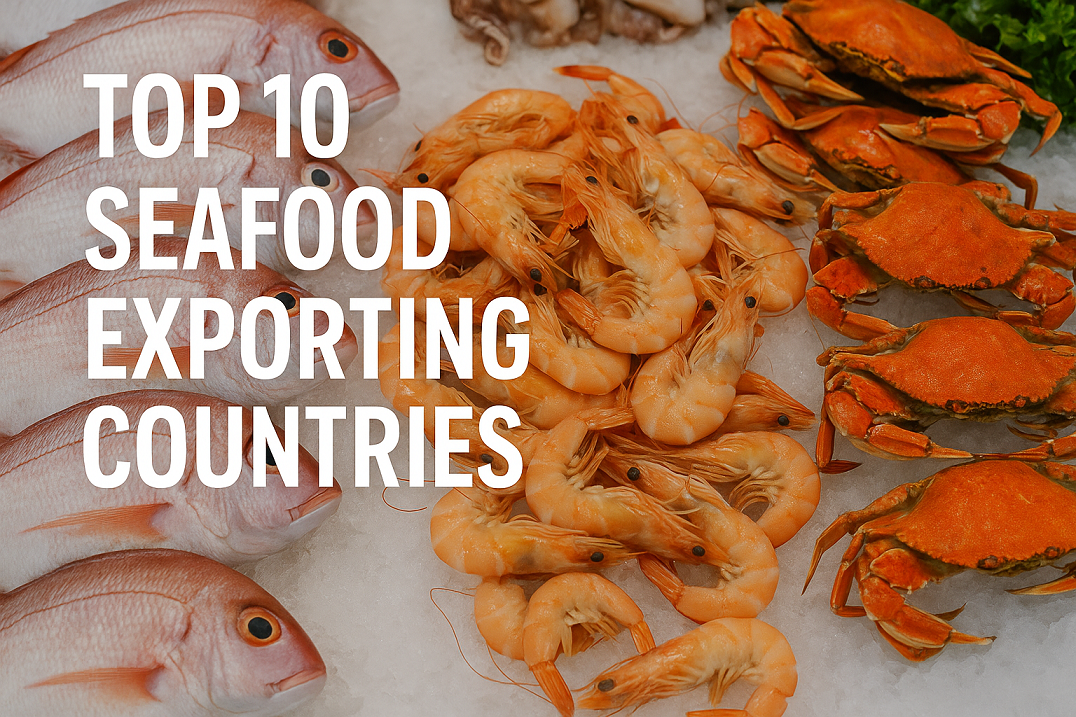Discover the top 10 seafood exporting countries in 2025 and their key global markets. Gain insights into how the fishing economy and global fish trade are evolving.

Why Global Seafood Exporters Matter in the Modern Maritime Economy
Seafood is more than just food—it’s a critical driver of maritime economies, international trade, and food security across continents. In 2025, global seafood trade is estimated to surpass $165 billion USD, according to recent figures from UNCTAD and the Food and Agriculture Organization (FAO). For many countries, fish and seafood exports represent not only economic growth but also cultural identity, coastal employment, and environmental stewardship.
The importance of seafood exporters today lies in their ability to supply diverse markets while managing sustainable fishing practices. With increasing demand for high-protein, low-carbon food sources, the global fish trade now plays a vital role in both maritime logistics and climate resilience. From wild-caught salmon in Norway to farmed shrimp in Vietnam, seafood touches nearly every region of the world—and its supply chains are deeply tied to maritime infrastructure, port efficiency, and global compliance standards.
–
Top 10 Seafood Exporting Countries in 2025
Each of these top countries has established a robust combination of fishing fleets, aquaculture operations, processing capacity, and trade agreements to lead the market.
1. China
Exports (2025 est.): $24.8 billion USD
Key Markets: Japan, U.S., South Korea, EU
China remains the world’s largest seafood exporter, thanks to its massive aquaculture industry and modernized processing facilities. While wild capture fisheries have plateaued, China’s inland and marine aquaculture continues to grow, especially for species like tilapia, carp, and shrimp.
China’s seafood logistics benefit from high-volume ports like Qingdao and Ningbo-Zhoushan. However, rising scrutiny over IUU (Illegal, Unreported, and Unregulated) fishing has led to reforms and international transparency commitments under pressure from Port State Control authorities and global NGOs.
2. Norway
Exports (2025 est.): $15.9 billion USD
Key Markets: EU (especially France and Germany), U.S., China
Famous for its premium Atlantic salmon, cod, and mackerel, Norway leads in value-added seafood exports. Through Norwegian Seafood Council branding and tight regulations overseen by DNV and IMARest, Norway has cultivated an image of sustainable, traceable seafood.
Aquaculture now accounts for over 60% of Norway’s seafood exports, with innovation in closed-containment systems and AI-based monitoring gaining attention. Ports like Bergen and Tromsø play a key role in integrating logistics with cold chain technologies.
3. Vietnam
Exports (2025 est.): $10.7 billion USD
Key Markets: U.S., Japan, China, EU
Vietnam has risen sharply as a top shrimp and pangasius exporter, backed by government subsidies and strategic modernization of seafood processing hubs in the Mekong Delta. Its industry is driven by compliance with EU food safety directives and ISO 22000 certifications.
Despite challenges with water quality and climate change, the country has embraced sustainable aquaculture, working closely with FAO and the World Bank on blue economy initiatives.
4. India
Exports (2025 est.): $9.3 billion USD
Key Markets: U.S., China, Middle East, EU
India’s Marine Products Export Development Authority (MPEDA) supports a vibrant seafood sector, primarily exporting shrimp, cuttlefish, and squid. The east coast port of Visakhapatnam is a major seafood gateway.
India is investing in traceability tools and blockchain to meet international standards and reduce rejections due to residues or temperature abuse in transit. Training programs through Maritime Knowledge India and the Central Institute of Fisheries Education are modernizing coastal workforce skills.
5. Chile
Exports (2025 est.): $7.8 billion USD
Key Markets: U.S., Japan, Brazil, China
Chile’s cold southern waters are ideal for salmon farming, placing the country among the top exporters of farmed salmon globally. After battling major disease outbreaks in the 2010s, Chile revamped biosecurity regulations under Sernapesca (Chile’s fisheries authority).
New advances in satellite monitoring and marine spatial planning, supported by Thetius and Global Fishing Watch, help manage both aquaculture and wild fishery zones effectively.
6. Thailand
Exports (2025 est.): $6.2 billion USD
Key Markets: U.S., Japan, China, EU
Known for its processed and canned tuna, Thailand has diversified into frozen shrimp, squid, and cuttlefish exports. Compliance with the EU IUU Regulation and ethical labor standards under ILO guidelines have improved after past controversies.
Thailand has invested in green port infrastructure and marine certification systems, working with ClassNK and Lloyd’s Register to meet global buyer requirements.
7. Canada
Exports (2025 est.): $5.5 billion USD
Key Markets: U.S., China, EU, Japan
Canada’s clean, cold waters produce high-value products like lobster, snow crab, and Pacific salmon. With over 70% of seafood exports bound for the U.S., Canada’s fishing industry benefits from fast logistics and Port of Halifax cold storage innovations.
The country’s strict sustainability policies are enforced by Fisheries and Oceans Canada (DFO) and supported by certifications from the Marine Stewardship Council (MSC).
8. Ecuador
Exports (2025 est.): $4.9 billion USD
Key Markets: EU, U.S., China
Ecuador is a powerhouse in whiteleg shrimp farming. The Guayaquil Port is the heart of its maritime seafood exports, equipped with temperature-controlled containers and smart inspection tools.
Strong environmental initiatives and aquaculture zoning efforts align Ecuador with the FAO Code of Conduct for Responsible Fisheries.
9. Russia
Exports (2025 est.): $4.2 billion USD
Key Markets: China, South Korea, EU (limited), domestic alliances
Russia’s seafood sector focuses on pollock, cod, and crab from the Far East. Despite geopolitical trade restrictions, bilateral agreements with China and other Asia-Pacific nations have stabilized exports.
Modernization of the Murmansk and Vladivostok ports and investment in factory trawlers have enhanced Russia’s processing capacity and traceability.
10. Indonesia
Exports (2025 est.): $4.0 billion USD
Key Markets: U.S., China, Japan, EU
Indonesia exports a diverse range of seafood—tuna, shrimp, seaweed—thanks to its vast archipelago and rich marine biodiversity. The government’s One Data Policy and partnership with NOAA and WRI aim to reduce IUU fishing.
Domestic logistics remain a challenge, but improved infrastructure at ports like Bitung and Surabaya is helping to streamline cold chain operations.
–
Major Trends in the Global Fish Trade
The global seafood trade is being shaped by several key developments:
- Sustainable Sourcing: More buyers require MSC, ASC, or Fair Trade certifications.
- Cold Chain Technologies: Smart containers and AI temperature monitoring reduce spoilage.
- Digital Traceability: Blockchain, QR codes, and data platforms improve food safety.
- Green Shipping: Exporters invest in lower-emission shipping and port electrification.
- Geopolitical Trade Shifts: Sanctions, tariffs, and climate disruptions affect seafood flows.
Real-World Impact: Seafood and Maritime Logistics
The logistics of seafood exports are incredibly time-sensitive. A delay of 12 hours in a tropical port could result in cargo rejection worth millions. That’s why many exporters rely on integrated cold chains, just-in-time shipping, and smart port technologies.
Take Norway for instance: salmon packed in Bergen in the morning can be on a sushi plate in Tokyo within 36 hours. This speed depends on meticulous coordination between maritime carriers, customs, and food safety inspectors.
Ecuador’s shrimp industry uses refrigerated containers with real-time tracking provided by companies like Maersk and CMA CGM. These systems reduce risk and enhance market confidence.
FAQs
Which country is the largest seafood exporter in 2025?
China holds the top spot, primarily due to its massive aquaculture sector and global processing capacity.
Why is Norway a leader in seafood exports?
Norway combines strict regulations, sustainability branding, and efficient cold-chain logistics to maintain a strong global market.
What challenges do seafood exporters face?
Key challenges include IUU fishing, food safety regulations, trade tariffs, and climate-related disruptions.
How is climate change affecting seafood exports?
Changing ocean temperatures and acidification impact fish migration, aquaculture viability, and harvest yields.
What is the role of maritime infrastructure in seafood exports?
Efficient ports, cold storage, traceability systems, and maritime logistics are crucial to delivering fresh seafood globally.
Are all top exporters focused on sustainability?
Not all equally, but pressure from buyers and regulators is pushing countries toward certifications and responsible sourcing.
Is aquaculture replacing wild fisheries?
Aquaculture is supplementing—not replacing—wild fisheries, but it’s growing rapidly due to its scalability.
Conclusion
In 2025, the global seafood trade continues to be a powerful engine of maritime economic growth, innovation, and sustainability. The top seafood exporters—from China and Norway to India and Indonesia—are shaping not only what lands on our plates but how maritime systems adapt to new global realities.
As shipping routes, technologies, and regulations evolve, so too must the strategies of exporters, maritime authorities, and port operators. To stay competitive and sustainable, seafood-exporting nations must continue investing in green infrastructure, digital traceability, and international collaboration.
Understanding the seafood export landscape is essential for everyone—from maritime students to logistics professionals—seeking to navigate the intersection of food, trade, and ocean stewardship.
References
- UNCTAD. (2024). Review of Maritime Transport. https://unctad.org/publication/review-maritime-transport-2024
- FAO. (2024). The State of World Fisheries and Aquaculture. https://www.fao.org/publications/sofia
- Global Fishing Watch. https://globalfishingwatch.org
- Norwegian Seafood Council. https://seafood.no
- Fisheries and Oceans Canada. https://www.dfo-mpo.gc.ca
- Sernapesca Chile. http://www.sernapesca.cl
- Marine Stewardship Council (MSC). https://www.msc.org
- World Bank Blue Economy Initiative. https://www.worldbank.org/en/topic/oceans-fisheries-and-coastal-economies
- MarineTraffic. https://www.marinetraffic.com

